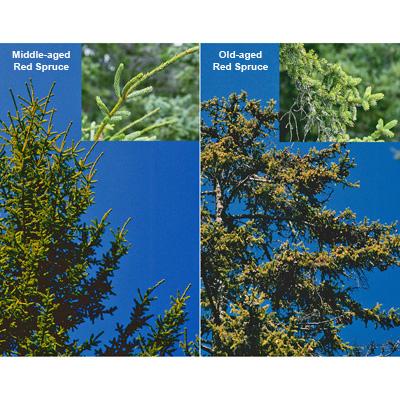Understanding the Molecular Basis of Age-Related Productivity Decline in Red Spruce: Integrating Physiological and Genomics Approaches

Stem wood growth in trees peaks at middle-age and declines thereafter. This trend is a principal factor in determining optimum ages for tree harvest and for projecting carbon sequestration rates in forests. However, the physiological mechanisms underlying age/size-related growth decline are poorly understood. As part of their ongoing research into these phenomena, NSRC researchers incorporated a genomics (field of genetics) study into their investigation of growth in red spruce. Previous research demonstrated that carbohydrate availability does not limit productivity as spruce trees age, which suggests that observed trends may instead be related to differences in carbon distribution within trees.
To better understand how older trees differed from younger trees in using carbohydrates for growth, researchers investigated the activity of genes associated with invertase, an enzyme that breaks down sucrose (sugar) for use in tree growth. Researchers analyzed developing foliage and twig tissue from juvenile, middle-age, and old spruce trees during the spring/early summer period of maximum tissue growth.
Analysis of invertase gene activity revealed the greatest expression of genes that code for the sucrose-cleaving enzyme in middle-age trees, the tree life-stage with the greatest growth rates. This study provided the first link between age/size-related gene expression and growth patterns in red spruce and established a pathway that may ultimately link genetically determined aging to behavior at the tree-level. In addition, studying the connection between gene expression and growth may provide a useful basis for distinguishing productive from non-productive red spruce genotypes in the Northern Forest.
